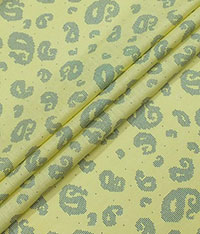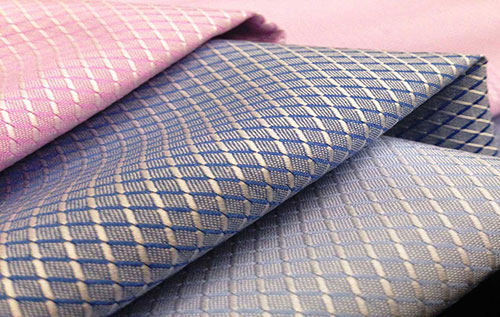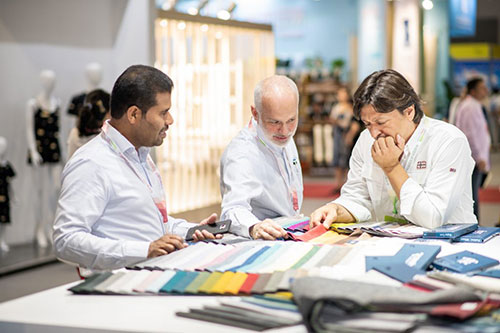FW
The wool market in Australia has been hit by a rash of unforeseen disturbances. Auction sales were cancelled due to a cyberattack on a software provider. Other factors include lower wool supply and low stocks of wool in the processing pipeline, slower economic conditions in key consuming markets and in recent weeks the onset of COVID-19. Since China is Australia’s biggest market for wool apparel products Coronavirus COVID-19) is expected to have some effects on the wool industry and the fashion industry in general. Despite the drought biting hard throughout 2019, many woolgrowers were clearly not willing to sell their wool at lower prices.
Meanwhile, the industry has continued its multi-season marketing push with mills and designers. Anlaby Station, Australia’s oldest merino wool sheep farm, created a six-piece travel collection using luxuriously soft 19 micron Australian merino wool. Pieces include a sweater, T-shirt, leisure pant, eye mask, travel poncho and a shawl that can double as a blanket on flights.
Naturally biodegradable and renewable, wool represents the natural choice to respect the planet while wearing a comfortable and luxury garment. Merino wool is the perfect natural and precious fiber to create a product that carries within itself the values of comfort and well-being, sustainability and excellence.
"Though cotton continues to be in demand among apparel manufacturers, manmade fibers (MMF) like polyester are also finding favor with brands, retailers and consumers as they are light weight and available in multiple categories. Classified as organic and inorganic, man-made fibers are produced by combining polymers or small molecules of raw materials, mainly of petroleum-based chemicals. Organic MMFs are made either by transforming natural polymers or from synthetic polymers."
 Though cotton continues to be in demand among apparel manufacturers, manmade fibers (MMF) like polyester are also finding favor with brands, retailers and consumers as they are light weight and available in multiple categories. Classified as organic and inorganic, man-made fibers are produced by combining polymers or small molecules of raw materials, mainly of petroleum-based chemicals. Organic MMFs are made either by transforming natural polymers or from synthetic polymers. On the other hand, inorganic fibers are produced by bi/multi-component fibers etc.
Though cotton continues to be in demand among apparel manufacturers, manmade fibers (MMF) like polyester are also finding favor with brands, retailers and consumers as they are light weight and available in multiple categories. Classified as organic and inorganic, man-made fibers are produced by combining polymers or small molecules of raw materials, mainly of petroleum-based chemicals. Organic MMFs are made either by transforming natural polymers or from synthetic polymers. On the other hand, inorganic fibers are produced by bi/multi-component fibers etc.
Polyester driving demand for MMF
A large part of the growth in MMF like polyester comes from China followed by India and Southeast Asia. China has a strong demand for polyester and accounts for 69 per cent of all polyester fiber production globally, and if India and Southeast Asia are added, these three regions represent 86 per cent of global production. In global apparel trade, share of polyester-based apparel has increased 9 percentage points (pp) since 2007.
However, India is still behind other countries in the production of manmade fibers as it still focuses on cotton. Its MMF textile and apparel exports and raw-materials are still much lower than China, Bangladesh, Vietnam, and Turkey statistically.
Its MMF textile and apparel exports and raw-materials are still much lower than China, Bangladesh, Vietnam, and Turkey statistically.
Tech innovations boost MMF demand
However, the MMF industry in India is quite progressive as it makes heavy investments in world-class manufacturing plants, continuous innovation, new product mix and strategic market expansion. Indian MMF fabrics are renowned across the world for their excellent workmanship, colors and durability. Innovations in technology with wider variety and faster turnaround has further boosted the MMF market as consumers are increasingly looking for product attributes in garments like wrinkle-free, breathable, water proofing fabric properties etc. The European regulations require flame retardant finish on kids garments and such norms are finding their way into India as well.
An organised sector, the manmade fiber industry is also the largest export earning segment for India. The country ranks sixth in exports of MMF textiles. However, the sector is troubled by dumping of imported MMF textiles from countries like Vietnam, China and Bangladesh. During April-July in 2019, the import of MMF textiles increased almost 26 per cent in value terms at $869 million compared to $711 million in the previous year.
Surat in India contributes 40 per cent to MMF demand
The country’s largest MMF hub, Surat produces around 3.5 crore meters of MMF annually, contributing 40 per cent of the country’s man-made fabric demand. Earlier this year, the Union government launched a support and outreach program to boost the MMF industry in India. It also revised the basic duty charges for MMF which not only relaxed the industry leaders but also resulted in a positive spike in sales for the winter season. The industry was happy as they finally could compete with the pricing offered by imported China or Bangladesh products.
Increased demand for MMFs from Ludhiana cluster
Though Ludhiana is one of the principal producers of woolen and acrylic knitwear, it also manufactures polyester based products. The city is also witnessing increased demand for nylon and functional yarns which can be used to make t-shirts, shirts, pullovers, cardigans, track suits, socks, jersey, sweat shirts, gloves, shawls, inner garments, etc. This year the market has reportedly been good with winter coming on right schedule. Lots of old stock has been cleared and some also are relaxed with the GST troubles.
"Exhibitor registration for the autumn edition of Intertextile Shanghai Home Textiles has been strong since December last year. Renowned global players such as D Décor Home Fabrics (India), G M Syntex (India), Naturtex (Hungary) and SIC Global Textiles (Poland) are amongst those who have already confirmed their participation. To be held from August 24-26 2020, the fair is the largest trade platform in China for international buyers to meet potential supply partners."
 Exhibitor registration for the autumn edition of Intertextile Shanghai Home Textiles has been strong since December last year. Renowned global players such as D Décor Home Fabrics (India), G M Syntex (India), Naturtex (Hungary) and SIC Global Textiles (Poland) are amongst those who have already confirmed their participation. To be held from August 24-26 2020, the fair is the largest trade platform in China for international buyers to meet potential supply partners.
Exhibitor registration for the autumn edition of Intertextile Shanghai Home Textiles has been strong since December last year. Renowned global players such as D Décor Home Fabrics (India), G M Syntex (India), Naturtex (Hungary) and SIC Global Textiles (Poland) are amongst those who have already confirmed their participation. To be held from August 24-26 2020, the fair is the largest trade platform in China for international buyers to meet potential supply partners.
“We are planning for all our trade fairs in the second half of the year to go ahead as scheduled following the disruptions from the COVID-19 virus to our events earlier in the year,” says Wendy Wen, Senior General Manager of Messe Frankfurt (HK) Ltd said. “Although the virus outbreak will no doubt have an effect on the Chinese economy, there were strong economic figures in the Chinese home textiles industry last year, so we expect the economy and this sector to rebound strongly once the virus is brought under control. We look forward to the upcoming autumn edition and our teams will leave no stone unturned to ensure a successful trade fair for domestic and international exhibitors and visitors alike.” She explained.
As the leading business platform for home and contract textile industry in the Asia Pacific region, participants can always find latest innovations and trends of the textile and interior design industry. This year, the fair continues to cover the entire spectrum of home and contract textile products including: Decorative Fabrics (Upholstery & Curtains); Bedding, Bath, Kitchen & Table; Carpets & Rugs; Sun-Protection; Wall coverings; Textile Editors; Whole Home Products; Digital Print & Technics; Fibres, Yarns & Chemicals; Textile Designs.
can always find latest innovations and trends of the textile and interior design industry. This year, the fair continues to cover the entire spectrum of home and contract textile products including: Decorative Fabrics (Upholstery & Curtains); Bedding, Bath, Kitchen & Table; Carpets & Rugs; Sun-Protection; Wall coverings; Textile Editors; Whole Home Products; Digital Print & Technics; Fibres, Yarns & Chemicals; Textile Designs.
Intertextile has tied up with renowned international forecasting agency France-based NellyRodi once more to present the latest international home furnishing trends. A trend committee led by NellyRodi comprising top forecasters including Carlotta Montaldo, Juliette Lamarca, Shen Lei and Studio NOCC will be for determining major design trends which will be demonstrated in the three-day fair through a series of events and displays.
Intertextile Shanghai Home Textiles-Autumn edition is organised by Messe Frankfurt (HK); the Sub-Council of Textile Industry, CCPIT; and the China Home Textile Association (CHTA).
From July to February, Bangladesh’s exports were 4.8 per cent lower than in the same period in the last fiscal year. Apparel is the largest segment contributing over 80 per cent to total exports. The biggest supplier of raw materials, China, is at the heart of the outbreak. About 46 per cent of the raw materials for Bangladesh’s readymade garment industry are sourced from China.
Bangladesh’s apparel sector is being hit by coronavirus-related supply chain disorders, with prices for raw materials soaring. As materials from China fail to arrive on time, prices of local stocks of items have gone up by nearly 50 per cent in some cases. Some factory owners have been forced to bring raw materials in by air to meet manufacturing deadlines. And the sector is gearing up for a prolonged crisis as the virus continues to spread worldwide, with fears that destination markets in the US and Europe will be affected. Bangladesh imports some 60 per cent of its woven fabrics from China. Some 15 per cent to 20 per cent of raw materials and 80 per cent to 85 per cent of dyeing chemicals and accessories of the knitwear sector comes from China. And some 40 per cent of raw materials for garment accessories and the packaging manufacturing industry also comes from China every year.
Significant progress has been made in the development of environmentally sustainable waterproof breathable fabrics. Waterproof breathable fabrics have become extremely popular in a number of applications -- including athleisure apparel, outdoor apparel, workwear and sportswear -- because of the levels of protection and comfort they provide. As a result, many players have entered the market, competition has become fierce, and the range of waterproof breathable fabrics now available is diverse. Several manufacturers are experimenting with the fiber compositions of waterproof breathable fabrics and are utilising natural fibers -- including organic cotton -- and fibers derived from recycled waste materials. Materials used in the manufacture of waterproof breathable fabrics include membranes and durable water repellent finishes. These are essential to the manufacture of waterproof breathable fabrics, and are required to impart waterproof properties -- especially in the outdoor apparel sector.
However, there remains much room for improvement in the development of waterproof breathable fabrics which are environmentally sustainable. Also, much work needs to be done to improve the understanding regarding the environmental sustainability credentials of materials made using alternative chemistries, especially as the hazards associated with some of them -- such as those incorporating dendrimers or nanoparticles -- are not widely documented
Fashion rental firm Rent the Runway has sent out an e-mail to consumers stating plans to ‘proactively provide details and additional transparency’ about its cleaning processes. It said that even when scientific information is still developing, it has ‘no reason to believe’ that it’s cleaning processes are ineffective against COVID-19. Also, it maintained that there is currently no evidence that COVID-19 can be transmitted from soft surfaces like fabric or carpet to people.
Besides, Rent the Runway has also added a new subscription option – a two-swap plan – to encourage more women to turn to renting rather than buying clothes. The firm had been offering two plans up until now – an unlimited subscription where users pay $159 per month to rent four items at any time while swapping them as frequently as they desire during the month.
And the second plan was a one-swap plan wherein customers pay $89 on a monthly basis to have four items at once that can be swapped at the turn of each month. The new model allows users to swap four items two times each month and it costs $135 per month.
Trading in the Chinese cotton yarn market remains weak. Market activity has been low. The epidemic has put a burden on the global cotton industry. Operating rate of fabric mills is still only 20 per cent. Orders currently catered to by weavers are mostly pre-holiday orders. Weavers mostly produce conventional varieties and open-end ones with lower value and less capital, which is commonly referred to as low-end fabric stocks. Most companies are now more worried about the epidemic.
International cotton yarn prices are weaker than domestic prices. Domestic yarn supply and demand are weak. Yarn mills have little inventory and there will be not much burden in the short term. Yarn mills have recovered much better than fabric mills.
Prices of international cotton yarns fell significantly faster than domestic ones. The imported yarn market will still have price advantages, or may still have a place in the Chinese market. In short, due to weak demand, the decline in cotton prices and the fall in imported yarn prices, the overall market price of cotton yarns in China is predicted to be weak. As the epidemic has spread to Japan, South Korea and Europe, there is a possibility of further spread, and the international market has become increasingly worried.
The UK Fashion and Textile (UKFT) association is launching two new initiatives to help support future talent in the industry. The mission is to promote the growth of entire supply chain across the UK. The projects aim at promoting the wealth of opportunities to young people working with a UK manufacturer. The first project is a campaign to promote a better understanding of sourcing, production and the benefits of UK manufacturing to the next generation of buyers, designers and entrepreneurs. UKFT will work with five universities a year for the next three years to help students get a better understanding of the manufacturing environment. The second is an initiative to help address one of the major barriers to growth faced by UK manufacturers - attracting new talent into the entire supply chain.
There are thousands of job vacancies in the UK fashion and textile manufacturing sector. Right now around 1,20,000 people are employed in the UK manufacturing industry and collectively they produce over nine billion pounds of fashion and textiles every year. UKFT is targeting more than 1,50,000 people and enabling them to have a go at making things, to talk to local employers about job opportunities and to find out about the new apprenticeships that are available for the sector.
The number of GOTS-certified facilities around the world increased 35 per cent in 2019. India and Bangladesh are on top with the highest number of GOTS-certified facilities. With the whole supply chain from farm to retail, along with suppliers of GOTS-approved chemical inputs, India has a unique position in the organic textile industry. More than ten Indian brands are offering GOTS-labeled goods in Indian retail. A few others are using GOTS as a risk management tool and may start labeling in future.
Global Organic Textile Standard (GOTS) is the stringent voluntary global standard for the entire post-harvest processing (which includes spinning, knitting, weaving, dyeing and manufacturing) of apparel and home textiles made with certified organic fiber (such as organic cotton and organic wool), and includes both environmental and social criteria. Products may only be sold with a GOTS label if the entire supply-chain is certified and the necessary scope and transaction certificates have been obtained to prove certification. An independent on-site inspection is carried out annually by GOTS-approved certifiers. Globally, more than three million workers work in GOTS-certified facilities. GOTS certification helps ensure compliance with each of the 17 UN Sustainable Development Goals (SDG). The new GOTS Version 6.0 is due to be released in spring 2020.
Maus Frères, the parent company of Lacoste, The Kooples, Gant and Aigle increased sales to (€3.2 billion) $3.6 billion during the end of last year. Additionally, Thierry Guibert, board member of the group, has also announced a name change for the group, that will now e known as MF Brands Group.
Leaving out the brand’s licenses, the Swiss group has increased total sales by 15 per cent to €2.6 billion (2.6 billion dollars). Lacoste has focused its resources on growing in new markets and repositioning, which has led the company to fall in volume and sales. The change in name from Maus Frères to MF Brands Group, is driven to internationalize its brands.












